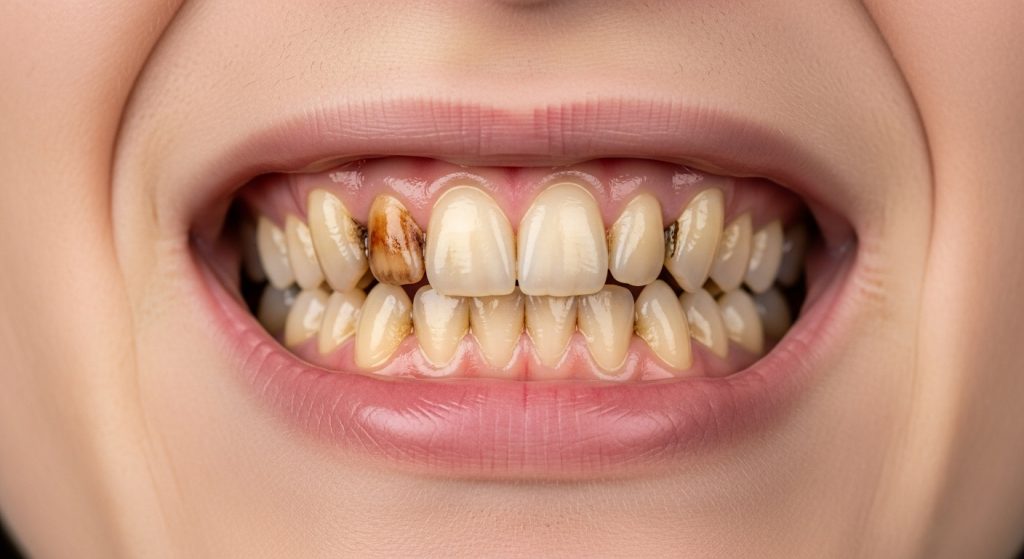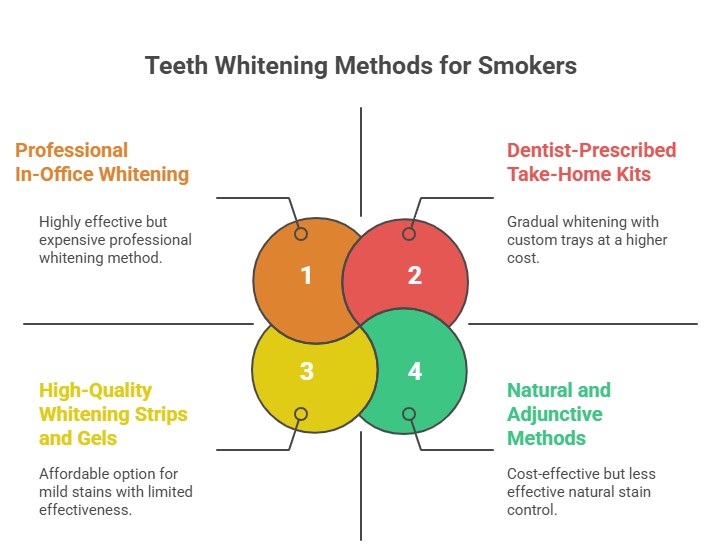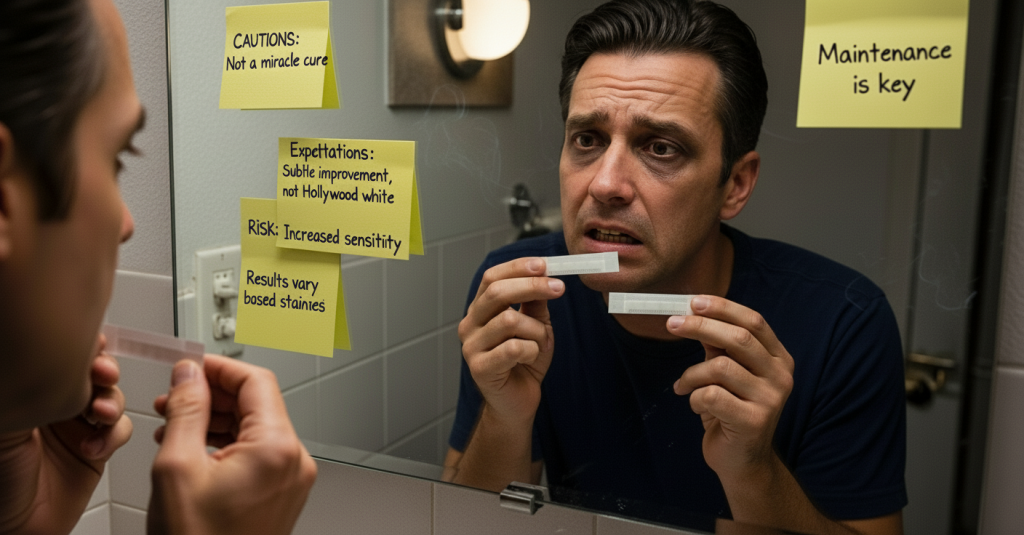Year after year, the golden-brown hue of nicotine and tar dulls your spark, changing a once-bright smile into an embarrassing one. Despite spending on “miracle teeth whitening for smokers” products, the results are often minimal and temporary. However, teeth whitening for smokers is achievable with a specialized strategy that targets tobacco stains using powerful, safe, and professional-grade solutions.
In this guide, we will explore why these stains are tough, the safest and most effective methods for teeth whitening for smokers, and steps to maintain a bright smile in the long term.
Why Nicotine Stains Are So Stubborn (The Smoker’s Challenge)
If you’ve ever wondered why your store-bought whitening strips work for your non-smoking friends but not for you, the answer lies in chemistry. The staining caused by tobacco is distinct and more pronounced than that of coffee, wine, or tea.

The Chemical Culprits: Nicotine and Tar
Nicotine and tar are the primary culprits of teeth discoloration, as they coat the teeth upon inhalation. Nicotine, colorless in its pure form, turns sticky and yellow-brown when oxidized in the mouth. Whereas tar, a dark, abrasive residue, sticks to enamel, creating porous pockets where nicotine settles, locking discoloration deep within the tooth structure.
According to the ADA, unlike surface (extrinsic) stains that can be scrubbed off, tobacco stains penetrate enamel and dentin, making mild over-the-counter teeth whitening for smokers products ineffective against decades-old nicotine stains.
Beyond Stains: Oral Health Factors
Smoking doesn’t just stain; it actively degrades your oral health in ways that make whitening treatments less effective:
| Oral Health Factor | Impact of Smoking | Effects on Teeth Whitening |
| Plaque & Tartar Build-Up | Smoking accelerates the accumulation of plaque and hardened tartar on teeth. | The sticky layer acts as a shield, trapping stains and preventing whitening agents from effectively reaching the enamel. Requires more frequent professional cleaning. |
| Saliva Production (Dry Mouth) | Frequent smoking significantly reduces saliva flow. | Less saliva means the mouth’s natural defense against acids and stains is compromised, allowing staining compounds to linger longer and become more severe. |
| Gum & Enamel Health | Smoking increases the risk of gum disease and can weaken enamel over time. | Compromised oral health means smokers must proceed with caution and professional guidance, as bleaching agents can cause increased pain and irritation (sensitivity). |
The Best Options for Teeth Whitening for Smokers
Overcoming nicotine stains requires powerful, professional intervention. The safest and most effective methods for teeth whitening for smokers are those that use a higher concentration of the active bleaching agent (usually hydrogen or carbamide peroxide) and are applied with precision.

1. Professional In-Office Whitening
Professional in-office whitening is the gold standard in teeth whitening for smokers, offering the most effective and fastest solution, particularly for those with moderate to severe staining. Dentists use higher-concentration whitening gel than over-the-counter products, paired with specialized techniques like UV light or laser to penetrate deep tar and nicotine stains.
This method is safest, with dental professionals applying protective barriers to gums and lips to prevent burns and monitoring tooth sensitivity. Results can vary up to 8 shades brighter in a single one-hour session.
2. Dentist-Prescribed Take-Home Kits (The Custom Approach)
For a gradual yet powerful whitening approach, a dentist-provided take-home kit is an ideal option. Unlike drugstore kits, these include custom-fitted trays molded to fit your teeth perfectly, ensuring even distribution of professional-grade gel.
This treatment, which is stronger than over-the-counter products, helps avoid patchy results associated with generic strips. You’ll wear the trays for 30 minutes to a few hours daily over one to two weeks, allowing the potent gel to break down deep nicotine stains effectively.
3. High-Quality Whitening Strips and Gels (The Maintenance & Mild Stain Option)
When it comes to teeth whitening for smokers, over-the-counter (OTC) options aren’t a substitute for professional treatment, but can help with minor surface-level discoloration or as a touch-up after professional whitening. Choose traditional strips or gels with the American Dental Association (ADA) Seal of Acceptance for proven safety and efficacy. These are ideal for recent or mild stains.
Peroxide-free alternatives, such as PAP strips, utilize gentler ingredients like phthalimidoperoxycaproic acid, making them suitable for teeth whitening for smokers with sensitive teeth or gums while still being effective. However, OTC products may be ineffective for deeply set stains, and overusing abrasive toothpastes or unapproved products can damage enamel and increase sensitivity. Always follow package instructions carefully.
4. Natural and Adjunctive Methods: Supportive Stain Control
These methods are low-intensity and supportive, not primary replacements for professional bleaching. They can be integrated into your routine to help maintain existing whiteness or reduce minor surface stain buildup.
However, they should always be used with caution and mindfulness regarding your enamel health.
| Method | How It Works | Key Caution for Smokers |
| Diluted Hydrogen Peroxide Rinse | Very low concentrations (typically 1–3%) can act as a mild bleaching agent to help lighten surface stains. | Do not overuse. Excessive or high-concentration use can increase temporary tooth sensitivity and may irritate your gums. |
| Baking Soda (Sodium Bicarbonate) | This acts as a mild abrasive, helping to gently scrub away surface deposits and external stains caused by smoking. | Use infrequently and gently. As an abrasive, repeated, aggressive use can lead to enamel wear and permanent damage. |
| Activated Charcoal / Oil Pulling | These are popular DIY remedies, often claiming to “pull” toxins or scrub stains. Evidence for deep cleaning is weak. | Be cautious with charcoal. Its abrasiveness, when used repeatedly, poses a risk of damaging the tooth enamel over time. Oil pulling offers subtle, mild benefits at best. |
| Microabrasion (Professional) | Performed by a dentist, this procedure uses an abrasive slurry (acid combined with micro-particles) to physically remove a thin, stained layer of the enamel. | This is a professional, in-office procedure, often used as a pre-treatment to physically remove very tough, thin surface stains before a formal whitening procedure. It should never be attempted at home. |
Contact Us for Help!
Have questions about teeth whitening for smokers?
Book a consultation to discuss your concerns and choose the best option for a lasting smile!
Daily Routine and Lifestyle for Maintaining Results
Teeth whitening for smokers is an investment; maintaining that bright smile, especially while continuing to smoke, requires diligence and persistence. Without a strategic maintenance routine, nicotine and tar will quickly re-stain your teeth.
Elevate Your Oral Hygiene
Your standard two-minute brush isn’t enough to combat tobacco residue.
- Brush with Purpose: Brush twice daily for two full minutes with an ADA-approved toothbrush and a high-quality whitening toothpaste formulated for deep stains (these often contain mild abrasives or peroxide boosters).
- Floss Religiously: Nicotine and tar love to settle between teeth where your brush can’t reach. Flossing daily is non-negotiable for preventing interproximal (between teeth) staining.
- Schedule Frequent Professional Cleanings: Smokers should discuss a more frequent teeth cleaning schedule with their dentist, typically every three to four months, instead of the standard six-month interval.
Post-Smoke Rinse Rule
An easy yet impactful approach! Rinse your mouth thoroughly with water immediately after every cigarette, cigar, or vape. This simple, effective habit dilutes and washes away nicotine and tar compounds before they settle into the enamel’s porous structure.
Be Mindful of “Color Bombs”
While tobacco is the primary cause of staining, foods and drinks such as coffee, black tea, red wine, dark sodas, and dark sauces (like soy sauce or balsamic vinegar) can accelerate staining, particularly after whitening when teeth are temporarily more porous. Limit or avoid these, and use a straw for high-staining liquids to reduce contact with front tooth surfaces.
The Ultimate Prevention: Quitting or Reducing
While we are discussing solutions for smokers, the most transformative and cost-effective change you can make is to quit or significantly reduce your tobacco use. Every dentist will tell you that no whitening treatment, regardless of its strength, can perfectly counteract the constant staining from smoking. If you want a permanently white smile, addressing the root cause is the key.
Cautions and Realistic Expectations
Before starting any intense whitening procedure, especially if you are a smoker, it is essential to have a realistic consultation with a dental professional to determine the best course of action.

Read More: Is Teeth Whitening Safe During Pregnancy?
Consult Your Dentist First
Always consult a professional for an oral health assessment before beginning any treatment. If you have active gum disease (periodontitis), significant tooth decay, or compromised enamel, whitening treatments can cause severe pain or damage. Your dentist will ensure your teeth and gums are healthy enough to undergo the therapy safely. Be sure to ask your dentist if you have other questions before your teeth whitening session.
Managing Sensitivity
Teeth whitening works by opening the pores of your enamel, which can expose the underlying nerves and cause temporary sensitivity. This can be more pronounced for smokers. Your dentist can recommend desensitizing toothpaste or adjust the concentration of the whitening gel to minimize discomfort. In almost all cases, this sensitivity subsides within 24 to 48 hours.
Alternative Solutions for Severe Stains
For rare cases where intense, long-standing tobacco stains penetrate the dentin (intrinsic stains) and resist professional bleaching, dentists may suggest cosmetic alternatives, such as dental veneers or crowns.
Veneers are thin porcelain or composite resin shells bonded to the front of teeth, providing a permanent, stain-resistant, bright solution. Crowns, also known as tooth-colored caps, are used when the entire tooth is severely compromised. These costly, permanent options guarantee results for the most challenging cases.
Brighter Smiles Are Possible for Smokers
Smoking creates some of the most stubborn teeth stains, but achieving an effectively whiter smile is absolutely possible with the right strategy. For those looking into teeth whitening for smokers, the journey starts with understanding why nicotine and tar stains are so difficult to remove. By selecting suitable whitening options and maintaining a consistent oral hygiene routine, smokers can significantly improve their smile.
While professional treatments often deliver the fastest and most dramatic results, high-quality at-home products can also be effective when used correctly. The key to maintaining a brighter smile lies in a three-part approach: limiting smoking (or quitting) when possible, adopting rigorous daily dental habits, and scheduling regular touch-ups with your dentist.
FAQ
Is teeth whitening safe for smokers?
Yes, it is generally safe when supervised or recommended by a dentist. Consulting a professional first is crucial to ensure underlying gum disease or severe sensitivity won’t be worsened by the treatment.
Can whitening toothpaste remove deep nicotine stains?
Whitening toothpastes effectively remove mild surface stains and maintain results post-professional treatment, but are typically not strong enough to lift deep, decades-old nicotine and tar stains.
How long does it take to see results?
Professional in-office whitening delivers dramatic results, often several shades lighter, in a single one-hour session. Customized take-home kits typically show noticeable results within one to two weeks of consistent daily use.
How soon after quitting smoking can I whiten?
Dentists commonly recommend waiting 2–4 weeks after quitting to allow gums and oral tissues to stabilize and for cleaning to remove residual stains, achieving the best possible results.
Can I continue smoking after whitening?
Yes, but your teeth will likely re-stain more quickly. Many dentists suggest avoiding smoking for at least 24–48 hours immediately after whitening. For best longevity, reducing or quitting is ideal.
Will whitening damage my enamel?
If done properly under supervision and using recommended concentrations, permanent damage is unlikely to occur. Overuse or misuse (exceptionally high concentrations, prolonged exposure) can erode enamel or increase sensitivity.
Have you ever had a teeth whitening experience? How do you feel about this procedure, or what questions are lingering in your head? Share your thoughts in the comments and join the conversation.




